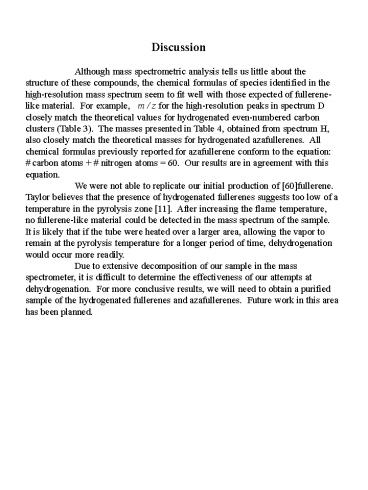Discussion PowerPoint PPT Presentation
Title: Discussion
1
Discussion Although mass spectrometric analysis
tells us little about the structure of these
compounds, the chemical formulas of species
identified in the high-resolution mass spectrum
seem to fit well with those expected of
fullerene-like material. For example, m / z
for the high-resolution peaks in spectrum D
closely match the theoretical values for
hydrogenated even-numbered carbon clusters (Table
3). The masses presented in Table 4, obtained
from spectrum H, also closely match the
theoretical masses for hydrogenated
azafullerenes. All chemical formulas previously
reported for azafullerene conform to the
equation carbon atoms nitrogen atoms 60.
Our results are in agreement with this equation.
We were not able to replicate our initial
production of 60fullerene. Taylor believes
that the presence of hydrogenated fullerenes
suggests too low of a temperature in the
pyrolysis zone 11. After increasing the flame
temperature, no fullerene-like material could be
detected in the mass spectrum of the sample. It
is likely that if the tube were heated over a
larger area, allowing the vapor to remain at the
pyrolysis temperature for a longer period of
time, dehydrogenation would occur more
readily. Due to extensive decomposition of our
sample in the mass spectrometer, it is difficult
to determine the effectiveness of our attempts at
dehydrogenation. For more conclusive results, we
will need to obtain a purified sample of the
hydrogenated fullerenes and azafullerenes.
Future work in this area has been planned.
PowerShow.com is a leading presentation sharing website. It has millions of presentations already uploaded and available with 1,000s more being uploaded by its users every day. Whatever your area of interest, here you’ll be able to find and view presentations you’ll love and possibly download. And, best of all, it is completely free and easy to use.
You might even have a presentation you’d like to share with others. If so, just upload it to PowerShow.com. We’ll convert it to an HTML5 slideshow that includes all the media types you’ve already added: audio, video, music, pictures, animations and transition effects. Then you can share it with your target audience as well as PowerShow.com’s millions of monthly visitors. And, again, it’s all free.
About the Developers
PowerShow.com is brought to you by CrystalGraphics, the award-winning developer and market-leading publisher of rich-media enhancement products for presentations. Our product offerings include millions of PowerPoint templates, diagrams, animated 3D characters and more.

